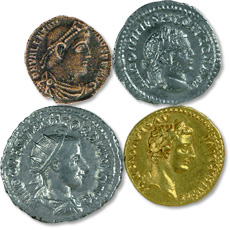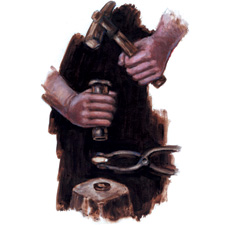Top Questions
Top Questions About Collecting Ancient Coins
We've compiled some of our most frequently asked questions and organized them by category. Choose your topic and read the answers below.
- How popular is ancient coin collecting?
- How can some ancient coins be so inexpensive?
- How do you know if coins are authentic?
- How are the coins acquired?
- Who grades the coins and by what standards?
- Have the coins been cleaned?
- How were ancient coins minted?
- What sizes and denominations are the coins?
- What is on the reverse of the coins?
- What coins are classified as ancient coins?
- How do I start an ancient coin collection?
1. How popular is ancient coin collecting?
U.S. coin collecting has grown in popularity since the 1850s, while ancient coin collecting has been a popular hobby for centuries worldwide. European monarchs and even popes have assembled impressive collections since medieval times (and ancient coin reference books date back to the 1500s).
Many people shy away from collecting ancient coins because they think they are complicated. But ancients are the basis for all modern coinage - the majority have an obverse and reverse design. And Roman Imperial coins have portraits, making them very similar to U.S. coins. Most collectors choose coins based on obverse designs, but some enjoy collecting various reverses.

Gold aureus of Nero; silver antoninianus of Valerian I; bronze coin of Constantine the Great
While it is possible to collect coins from nearly all of the Roman emperors, some are difficult to find because the emperors only ruled for a short time. Usurpers and self-proclaimed rulers also struck coins, and many of these are quite rare.
2. How can some ancient coins be so inexpensive?
Ancient civilizations issued coins from about 650 B.C. to A.D. 500, a span of 1,200 years, which is six times longer than the history of the United States. And there were hundreds of mints spread over a much larger area. Since there were no banks, coins were usually buried - and for various reasons, many were never retrieved.
Numerous hoards have been found in lands of former ancient empires, especially since the advent of the metal detector. Experts estimate that one half of 1% of all ancients ever struck survive today, which is still a sizable number. Compared to people collecting U.S. coins, the number collecting ancients is still relatively small. That means there aren't as many competing for the same coins, although some are still hard to find.
3. How do you know if coins are authentic?
Ancients have been studied and collected throughout the world for many centuries. Expertise in this field has been developed over a long period of time. All ancient coins offered by Littleton have been carefully examined by our experts and are guaranteed genuine.
4. How are the coins acquired?
Littleton obtains ancient coins from leading specialists throughout the world. All coins have been legally imported into the U.S. following all applicable laws and regulations.
5. Who grades the coins and by what standards?
Ancients have been studied and collected throughout the world for many centuries. Expertise in this field has been developed over a long period of time. All ancient coins offered by Littleton have been carefully examined by our experts and are guaranteed genuine.
6. Have the coins been cleaned?
Unlike modern issues, it is usually necessary for experts to clean ancient coins. As most are found in buried hoards, nearly all have been cleaned, even rarities worth thousands of dollars. Our experts clean the ancients we offer using a variety of techniques employed by world-class museums and leading coin authorities. Coins should never be cleaned except by experts.
7. How were ancient coins minted?
The earliest Roman coins and some Biblical issues were cast (molten metal poured into molds and allowed to harden). Ancient Roman coins were cast until about 211 B.C., then all issues were struck using hand-held dies and hammers. The design of one side was carved into a metal disk or die which fit into an anvil, and the design of the other side was carved into the base of a metal punch. A coin blank was placed on the die in the anvil, and the punch was placed over it. With one or more sharp blows of a hammer, a coin was made (as a result, ancients are sometimes weakly struck, off center or double struck).

Ancient coins were struck using hand-held dies and hammers.
8. What sizes and denominations are the coins?
While ancients can range in diameter from the size of a pea to the size of a silver dollar, there were general size standards for various denominations. Among the most familiar ancient Greek coins are the Stater, Drachm and Tetradrachm (equal to four Drachms). The most familiar ancient Roman silver coin for centuries was the Denarius, which was followed and replaced by the Antoninianus.
9. What is on the reverse of the coins?
The earliest Greek coins are uniface (a design only on one side with a punch-mark reverse), but most depict mythological figures and images on both sides. The obverse or "heads" side of most ancient Roman coins pictures the ruling emperor at the time of striking. The reverse usually depicts deities, mythological figures or symbols of the rulers' authority.
10. What coins are classified as ancient coins?
The earliest coins are attributed to Lydia in Asia Minor about 600-700 B.C., but coins may have been used earlier in China. The term "ancient" usually applies to coins from the earliest known issues to those struck during the first five centuries A.D., about 1200 years of coinage.
11. How do I start an ancient coin collection?
Though most collectors choose coins based on obverse designs, some enjoy collecting the various reverse designs. While it is possible to collect coins from nearly all of the Roman emperors, some are difficult to find because the emperors ruled for such a short time. Usurpers and self-proclaimed rulers also struck coins, and many of these are quite rare. To become more familiar with ancient coin collecting, it would be a good idea to review the information available on our How to Collect Ancient Coins page.
When you start collecting, keep in mind that you can purchase ancient coins easily and conveniently by mail no matter where you live. Littleton offers catalogs, price lists, and ancient coins "on approval" – so a large inventory is always available for you to choose from. You should only purchase ancient coins from a company that guarantees your satisfaction (like Littleton). For more ways Littleton can help you start and expand your collection, see What Can Littleton Do For Me?.

